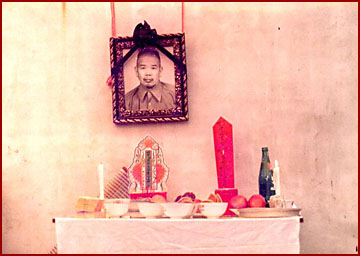 Fruit baskets and food offerings
Fruit baskets and food offerings
The fruit and bowls of food are offerings made to the deceased to earn the soul merits. They consist of foods that the deceased enjoyed eating in his or her lifetime. The food offerings are usually replaced daily, but fruits can be left on the altar for a little while longer. Offerings of fruits, vegetables, and other vegetarian foods are preferred; meats are avoided because they symbolize the killing of animals. These symbols strongly reflect the Buddhist religion.
Portrait
The portrait of the deceased on the altar lets mourners see an image of their loved one. In earlier times, portraits like the ones displayed in the Worshiping the Ancestors exhibition took the place of these small portraits. In the past, only wealthy families and members of the imperial court could afford elaborate commemorative portraits. In modern times, a photograph is a common replacement for an expensive commemorative portrait.
Plaques
The plaque under the portrait shows the name of the deceased person. These plaques usually give the name of the deceased and a short inscription, perhaps an epitaph of some sort. The larger, red object is another plaque. Instead of having inscriptions dedicated to the person depicted in the portrait, the larger plaque shows the family name or names of past ancestors. Memorial altars may include either of the two plaques or both.
Money
The money stacked off to the side is also an offering made to the soul of the deceased for use in the afterlife. The Chinese perceive the afterlife to be similar to real life. Since the deceased loved ones only recently arrived in the afterlife, they need money to help them get started.
Wine bottle and cups
Much like the food offerings, wine is placed on the altar for the benefit of the late family member's soul. During the funeral, more important necessities, paper symbols of money, clothing, and shoes, and today, even computers, are sacrificed. Daily luxuries, including food, wine, and small sums of money, are offered during the mourning period.
Back to altars.